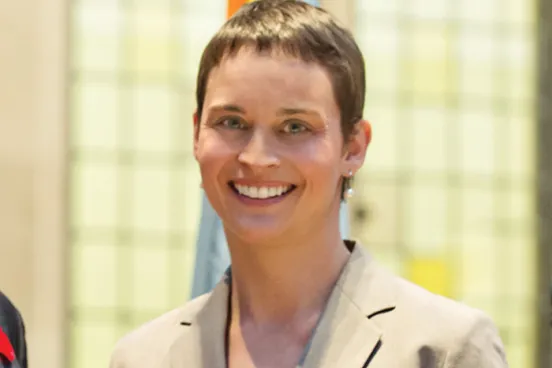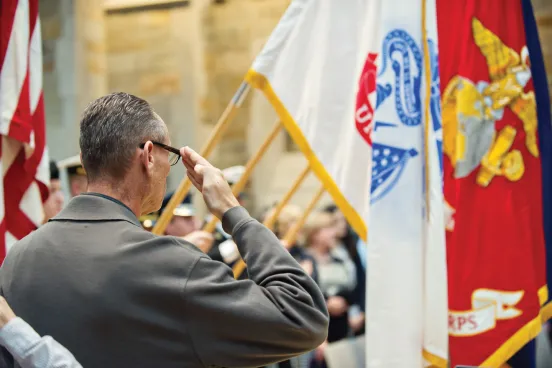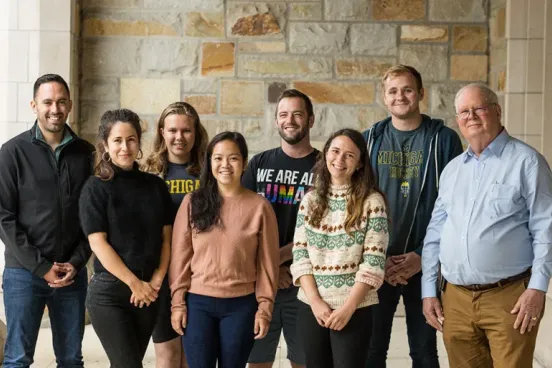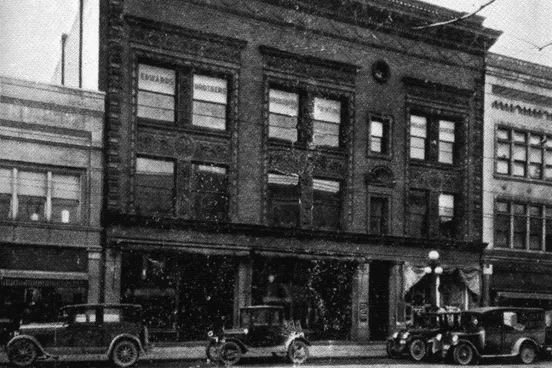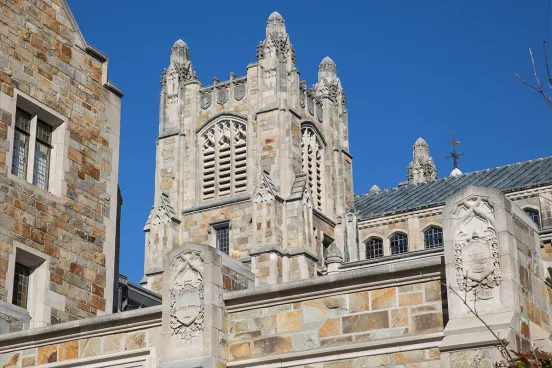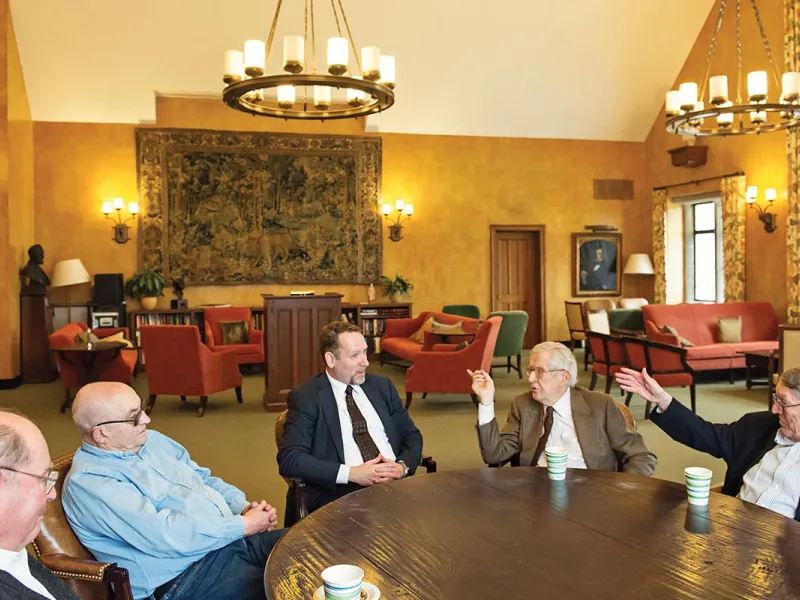
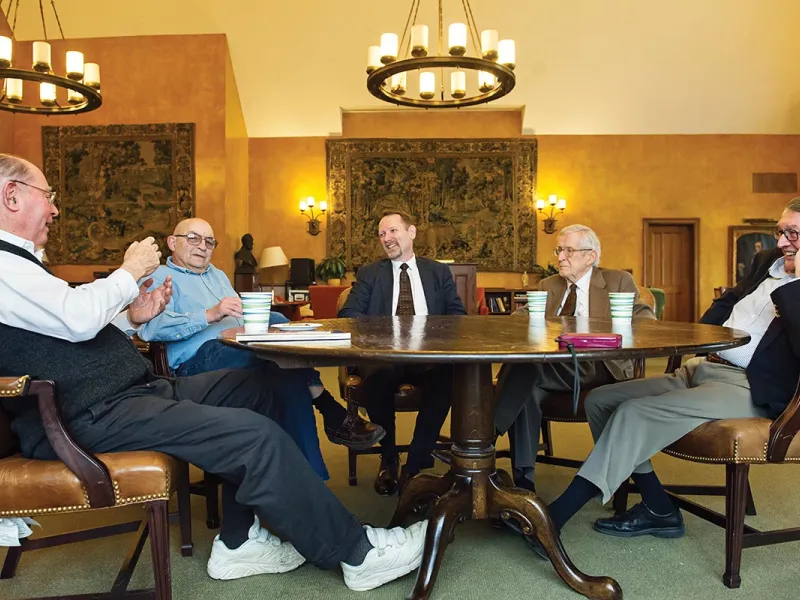
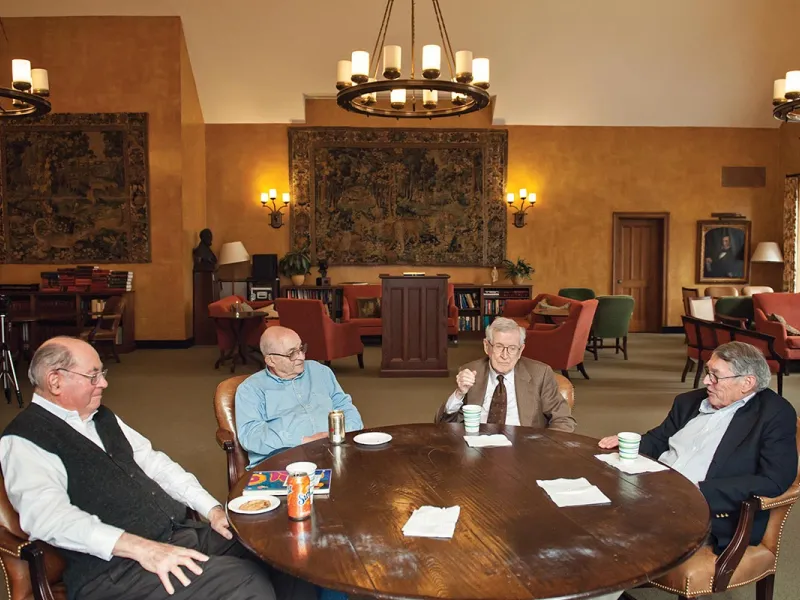
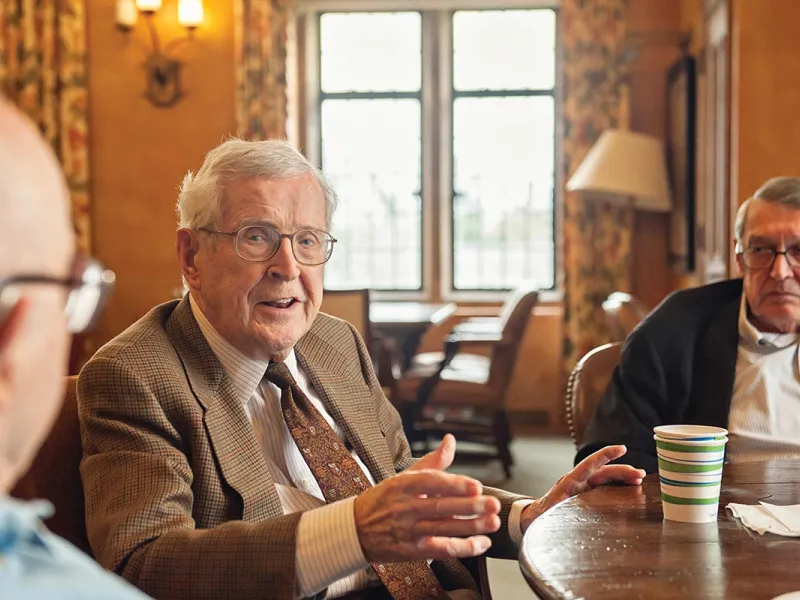
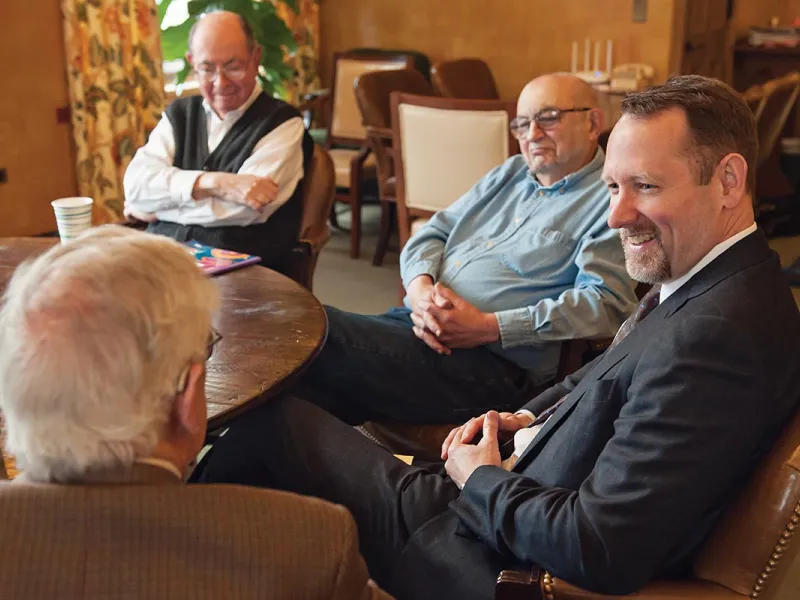
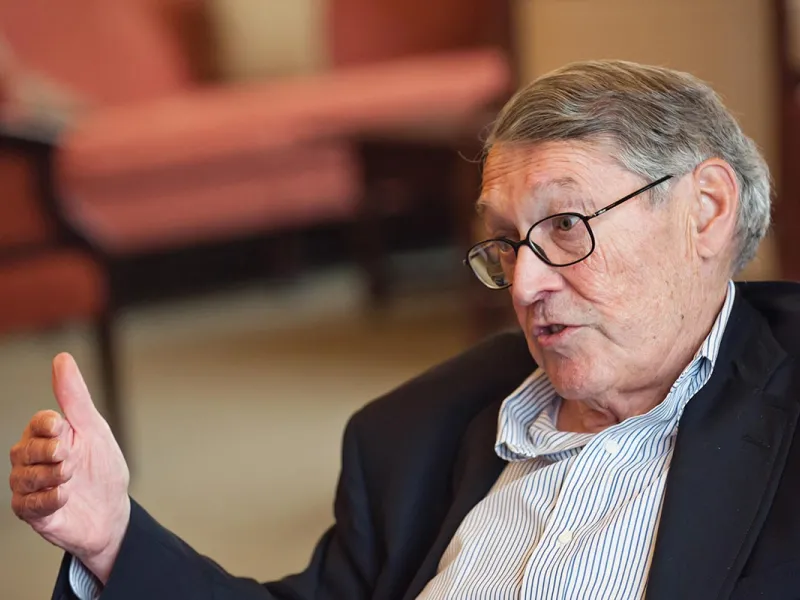
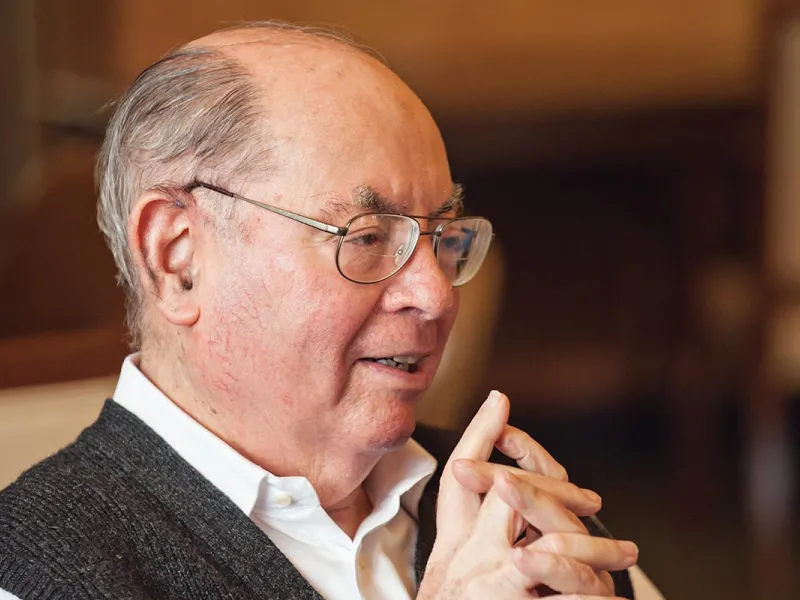
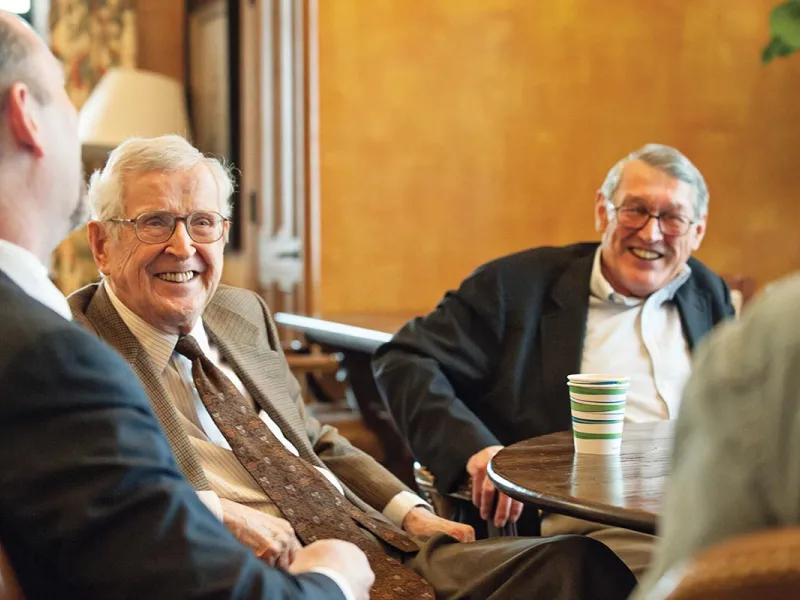
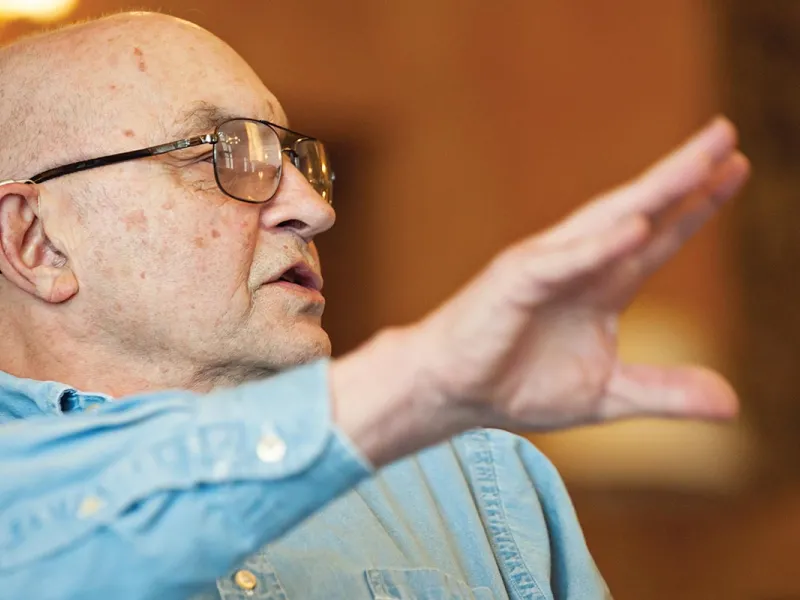
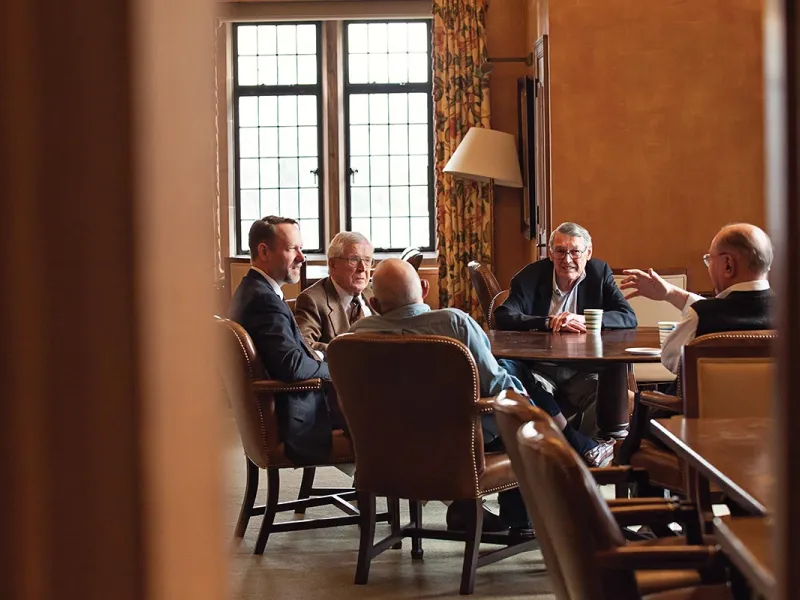
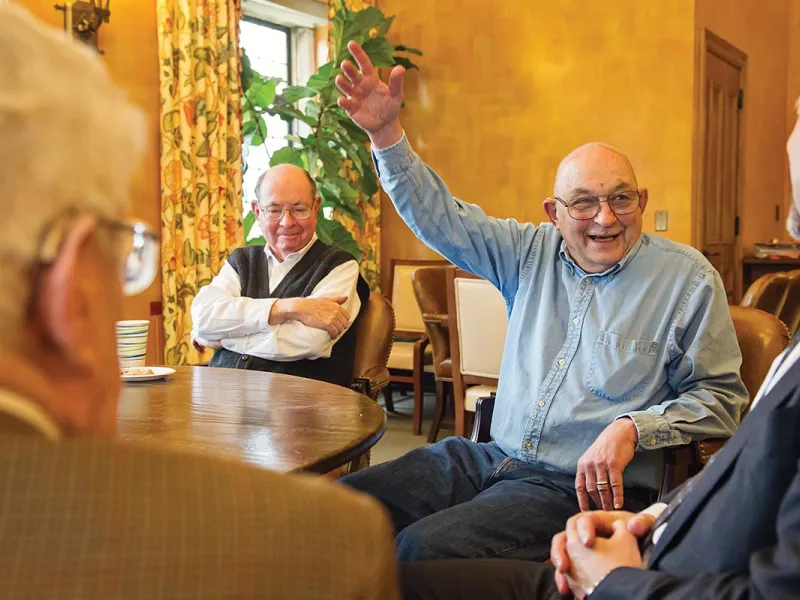
Yale Kamisar would like to set the record straight, once and for all.
Yes, yes, he threw a book and broke a student’s glasses. Yes, he paid to have the glasses fixed. But it was one book, one time, thrown to make a point about the case of a husband flinging a beer mug at his wife while she held a lit lamp—and the student seemed willfully disinclined to understand the professor’s point.
“So I threw the book, and it broke his glasses. But the glasses were on his desk, not on his face,” he said. “The story was soon embellished.”
Kamisar, the Clarence Darrow Distinguished University Professor of Law Emeritus, recounted the incident during a lively discussion in the faculty lounge on a recent day. It was a typical scene: several titans of legal doctrine, chatting about topics historical and current. Nearly every day in this room, some combination of emeritus faculty members gets together at this same table, sparring and collaborating as they have done for decades.
This day’s get-together began with Kamisar and Ted St. Antoine—the James E. & Sarah A. Degan Professor of Law Emeritus—chatting about the room in which they sat. It is an ornate room, with well-worn tapestries, curtains, and chandeliers that span much of the history of the Law School. You can imagine these professors sitting in exactly the same chairs 50 years ago—which may well have happened. John Reed joined the faculty in 1949 (the year before the Korean War began), Jerry Israel in 1961, and St. Antoine and Kamisar—the relative newcomers—in 1965. Today, they are as sharp as ever at ages 97 (Reed), 86 (Kamisar and St. Antoine), and 81 (Israel).
“Used to have a long couch over there,” said Kamisar—an authority on criminal procedure and constitutional law—nodding toward the back wall. “One of the deans, Bollinger I think, used to meet over there with his kitchen cabinet of faculty advisers.” St. Antoine: “No fooling.” Kamisar: “Every morning.”
Then Israel, the Alene and Allan F. Smith Professor of Law Emeritus and an authority on criminal procedure, entered the room, and the conversation quickly turned from reminiscences to legal issues of the day.
“I want to know what you think about Uber,” he announced in a booming voice, in reference to the ride-hailing app and a Seattle ordinance allowing the drivers to unionize. “I can understand why a group of solo barbers can’t get together because that would involve price fixing for hair cuts, but Seattle is allowing the so-called independent contractor drivers to bargain with Uber over their cut of what Uber charges.” St. Antoine replied that they had to establish an employee relationship to get union organizing rights. “There is talk that we need an intermediate form of worker classification” in general, said St. Antoine, a leading expert on labor law. He mentioned that unions initially were outlawed, and that Justice Oliver Wendell Holmes Jr. recognized workers’ right to organize trade unions and to strike. Israel pointed out that federal law treats Uber drivers as independent contractors, and St. Antoine said, “there certainly is going to be a federal preemption question.”
Legal legends discussing Justice Holmes, preemption, and the history of trade-union law. Just another day in the Michigan Law faculty lounge.
Yale KamisarSo I threw the book, and it broke his glasses
There are too many lawyers. Or maybe not. Law school should be two years instead of three. Or maybe not.
The emeritus faculty recalled other eras in which those two issues were debated, much as they are now. Discussion about too many lawyers led the group to point out that there aren’t necessarily too many of the kind of lawyers produced by top schools like Michigan—though it’s possible there are too many lawyers in general. In addition, “one of the suggestions is that we don’t have too many lawyers but need reallocation,” Reed pointed out. They also discussed St. Antoine’s idea from many years ago that legal insurance would be useful to many people. “I said at the time: The top 10 percent can afford lawyers, the bottom 20 percent has one appointed to them, and that leaves 70 percent in need of legal insurance or something like it,” St. Antoine said. “I wonder why that idea hasn’t taken off,” said Reed, the Thomas M. Cooley Professor of Law Emeritus and an authority on civil procedure and evidence.
Regarding two years for law school instead of three, Kamisar said to St. Antoine: “I looked over those reports that you sent to the president [Robben Fleming] when you were dean. There was talk in those days of cutting law school from three years to two.” St. Antoine replied, “There was a shortage of lawyers then; now, there is an overabundance—or some people view it that way. I argued then for a better use of the third year.”
They debated the merits of two versus three years, talked about apprenticeships for a third year, and discussed whether law school costs too much (yes, said Israel). But St. Antoine pointed out that the cost at Michigan has gone up in no small part because of a lower allocation of state funding. More than a quarter of the School’s funding used to come from the State, he said, but that is down to about 2 percent now.
They were less interested in talking about numbers, however, and more inclined to talk about the people and the culture of the Law School.
So began a discussion of colleagues of bygone eras and whether good grades predict high salaries.
They reminisced about faculty of the past: Hessel Yntema, who they said was a brilliant scholar, even if he sometimes butted heads with other faculty members; Paul Kauper, “a giant, literally and figuratively” at 6’6” or so; L. Hart Wright, who threw erasers at a few students to wake them up, and who made breakfast for a student who was always late to class, Kamisar recalled.
While many of the faculty members from long ago have passed away, Mark West, dean and Nippon Life Professor of Law—who stopped by for part of the conversation—pointed out that “most people are still around. Most people are still around this table.”
When West asked about a correlation between grades and jobs, the group recalled instances when grades were a strong indicator of future success. “The students who do the best academically get the best jobs,” St. Antoine said. They also recalled times when they knew certain students would have impressive careers. St. Antoine, for instance, knew from his classroom demeanor that Ron Olson, ’66—who would go on to be a widely known and respected litigator—would be successful. Others said the class of 1968, among others, stood out academically.
One student’s success was due in no small part to Reed’s intervention. It was 1954 or so, Reed recalled, and a student was so drunk that he went into the wrong house. He was charged with breaking and entering, and the dean planned to expel him. Reed reached out to the state bar and learned that the student still could pass the character and fitness test, even with his criminal record. At Reed’s urging, the dean allowed him to stay.
“He thanked me later with a letter,” Reed laughed, “that said he was practicing mostly ethical law and had married the girl he was with that night.”
Ted St. AntoineI argued then for a better use of the third year
Enough about the law and academia for a moment. Dean West had an important question for the group: Would they rather play for Bo Schembechler or current U-M football Coach Jim Harbaugh?
Reed prefers Harbaugh, whom he described as tough but kind. “He does not come across to me as a guy with a hammer,” Reed said.
St. Antoine noted that he never thought Schembechler “was that great” because he fared poorly against teams from what would become the Pac-12 conference.
Israel chose none of the above. “How about Fritz Crisler?” who coached the football team from 1938 to 1947, to which West joked, “Crisler to me is an arena. To you, he’s a person.”
All of the emeritus professors are familiar with numerous law schools. Israel visited as a professor at Stanford and other law schools; Kamisar taught at Harvard, the University of Minnesota, and the University of San Diego; Reed at Harvard and Yale, and as dean of the University of Colorado and Wayne State; and St. Antoine at Cambridge, Duke, and other law schools. All except St. Antoine attended other law schools: Israel, Yale; Kamisar, Columbia; and Reed, Cornell and Columbia.
So they are on firm footing when they compare Michigan Law to other schools. The scholastic rigor is similar to other top law schools, and has been for a long time, they said. “When I arrived,” said Reed, “teaching methods were similar to what I had encountered at Cornell” seven years earlier.
But the interactions among students and faculty members have long been the element that makes Michigan Law different from other schools, they said.
“The saying was always that the Michigan graduates were going to be the managing partners at firms. They were always so level-headed and easy to work with,” Israel said.
“I remember a semester that I taught at Harvard, and one of the Harvard wives said to my wife, ‘Ann Arbor—oh, that’s where everybody likes everybody,’” Reed said.
“Was that really true?” West asked. “Pretty darned close,” said St. Antoine, who recalled that by his second semester at Michigan, he and his wife had been in the homes of two-thirds of the faculty members for cocktail parties and other gatherings.
John ReedHe does not come across to me as a guy with a hammer
West had a question specifically for St. Antoine: “To what extent did you want to be dean?”
St. Antoine knew he was being considered for the position but had serious reservations about it. Then, “it was the middle of the night, and I probably had a couple of martinis.” He “invaded the mailboxes” of the search committee members and left notes withdrawing his name. The next morning he had a change of heart. “I just couldn’t say ‘no’ to colleagues if they wanted me.” He was dean from 1971 to 1978.
A few years ago, it was the 50th anniversary of Gideon v. Wainwright, in which the Supreme Court unanimously ruled that states are required under the Fourteenth Amendment to provide counsel in criminal cases to represent defendants who are unable to afford to pay their own attorneys. A mention of the case prompted Kamisar—widely regarded as the father of Miranda—to express concerns about the heavy caseloads of public defenders.
“A lot of them can’t do an adequate job,” he said. “They’re overwhelmed by the clients they already have.”
Israel wasn’t convinced. “Prosecutors have equally heavy caseloads,” he said. “And they have more to do.” Besides, he said, who would pay for more public defenders?
The two sparred a bit longer—good naturedly, but definitely not seeing eye to eye. They have been doing so for many years, “sometimes loudly and fiercely” about “the merits and demerits of a newly decided case,” Kamisar wrote in a Michigan Law Review article in 1995-1996.
On this day, he said, “No matter what side I take, you’re on the other.”
Israel smiled and shrugged. “That’s the nature of the ballgame.”
And so it is, but this also is the nature of the ballgame: When the gathering ended, after the sparring and reminiscing and laughing, the longtime colleagues and friends went their separate ways, but planned to come back another morning soon to do it all over again.
Jerry IsraelThat’s the nature of the ballgame.



